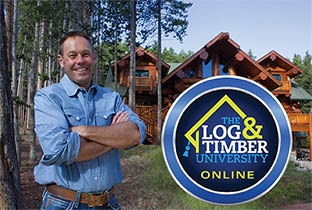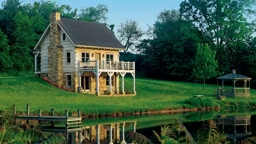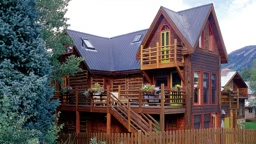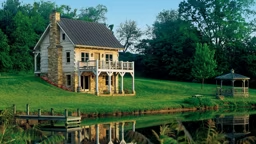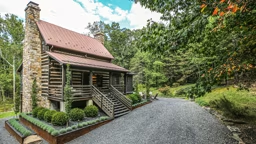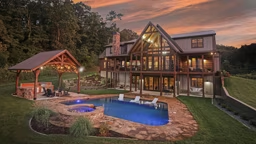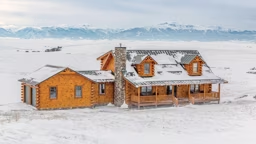 Many of Henry Steiner's 30 cabins still stand on the 140-acre property. George Frazer, who bought his Steiner cabin in 1960, recalls being told by neighbors that the home's back porch, which faces the Zigzag River, was originally considered the front entryway. Although the tin roofing is a later addition, the logs chinked with narrow wood strips, porch posts and purlins are all original.
Many of Henry Steiner's 30 cabins still stand on the 140-acre property. George Frazer, who bought his Steiner cabin in 1960, recalls being told by neighbors that the home's back porch, which faces the Zigzag River, was originally considered the front entryway. Although the tin roofing is a later addition, the logs chinked with narrow wood strips, porch posts and purlins are all original.
 The cabin's rear elevation combines horizontal notched logs, vertical chinked ones, and hand-hewn upper-level shingles. Homeowner Nancy Dougherty appreciates that the steep, cross-gabled roof is perfectly angled to let snow slide right off.
The cabin's rear elevation combines horizontal notched logs, vertical chinked ones, and hand-hewn upper-level shingles. Homeowner Nancy Dougherty appreciates that the steep, cross-gabled roof is perfectly angled to let snow slide right off.
Rustic log cabins
Over the course of the next two decades, Henry built approximately 30 rustic, log dwellings comprised of timbers felled onsite, glacial stones, river rock and other local resources. Today, many of the historic log cabins are used as weekend and summer retreats, whereas others have been converted into year-round homes.
Nancy Dougherty, a retired teacher, had never heard of Henry Steiner when she bought one of his enchanting cabins, a three-bedroom model, as her primary residence in 1975. "I was looking for a quiet place to raise my two sons and was attracted to the riverside setting and mountain views," she says. "The house was in pretty bad shape, but its hand- hewn logs and handcrafted details really appealed to me." Three decades later, Nancy is one of the leading experts on the area's famous Steiner cabins.
Family affair
"For Mr. Steiner, building cabins was a family affair," she says. "Almost all of his 13 children contributed to the process in some way." Henry's wife and daughters hand-peeled the logs. His sons cleared the land, cut trees into logs and shaved cedar into shingles. Since there wasn't electricity on the mountain, they used only manual tools for construction. Wielding 16-pound sledgehammers, the strongest of his sons turned giant boulders into flat-faced rocks intended for chimneys and massive fireplaces. John and Fred Steiner, the two eldest boys, built cabins and produced replacement logs and shakes until the mid-1960s.
 A built-in corner cabinet, crafted by John Steiner, pairs three half-log shelves with a cubby for storage. A serpentine root handle opens the cabinet's log-veneer door.
A built-in corner cabinet, crafted by John Steiner, pairs three half-log shelves with a cubby for storage. A serpentine root handle opens the cabinet's log-veneer door.
Historic, but sturdy
Lloyd Musser, curator of The Mt. Hood Cultural Center and Museum, explains that the Steiners never bought anything they could make. Most of the original multi-paned sliding windows still offer Nancy and her neighbors' unobstructed views of the magnificent outdoors. Everything was designed or chosen to be practical and sturdy. The rustic cabins originally featured kerosene lamps, wood stoves and gravity-fed water systems, but like most others, Nancy's cabin has been updated with electricity, a modern furnace and new plumbing.
Despite these improvements, the historic log cabin still looks pretty much the same as it did in 1933 when Suzette put it up for sale. "Today, the Steiner cabins in Rhododendron are considered extraordinary examples of 20th-century Oregon rustic style," Nancy says. "But to Henry, they were simply a matter of using what the land provided in the best way he knew how. I'm sure he'd be delighted to know how popular they still are."
